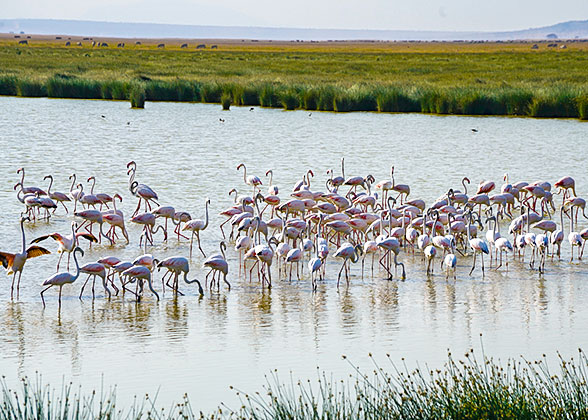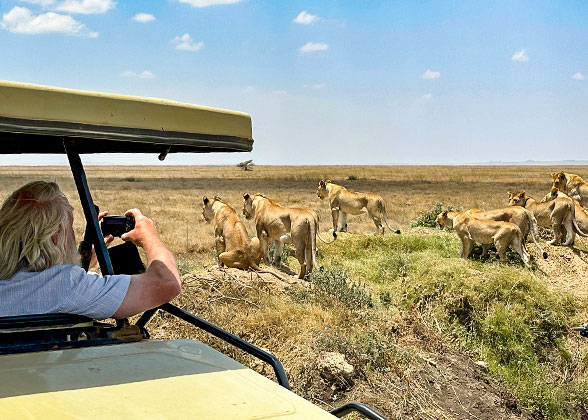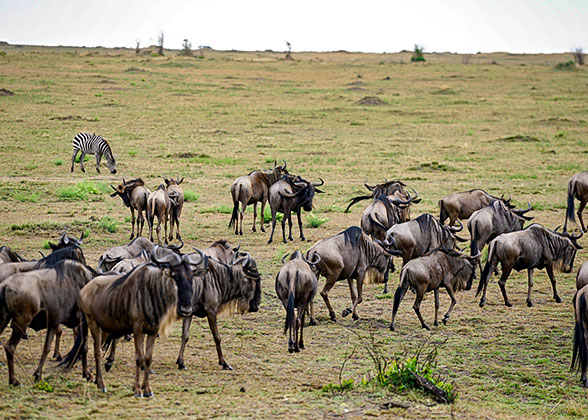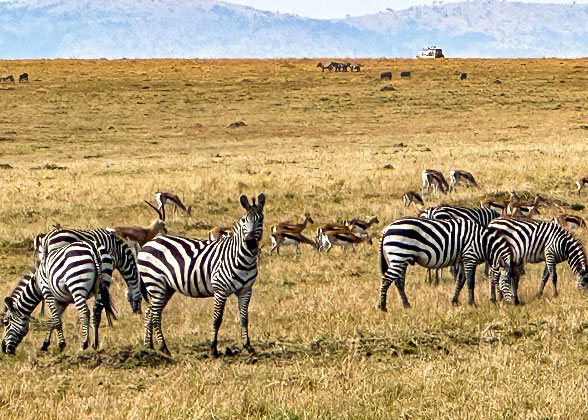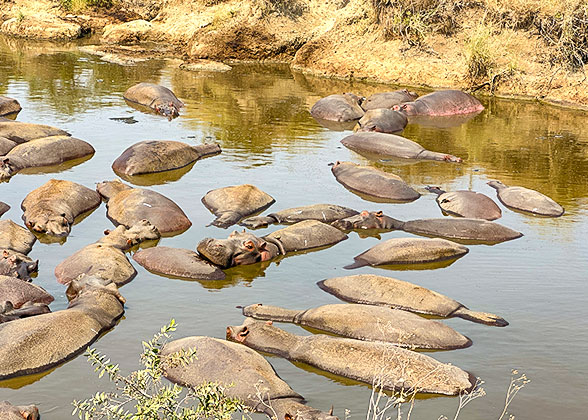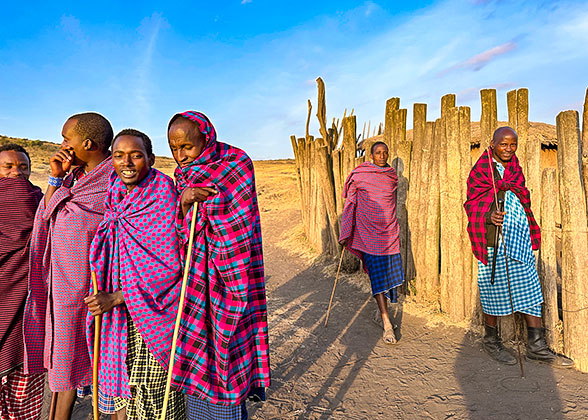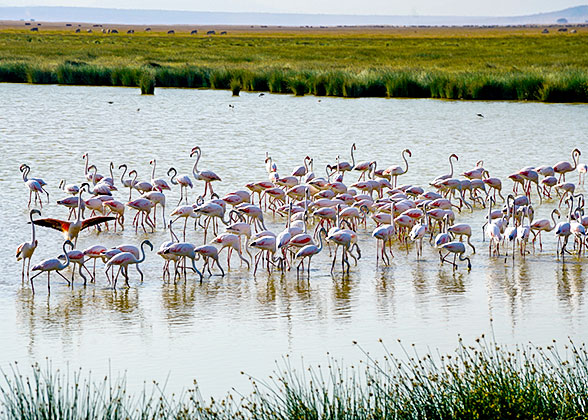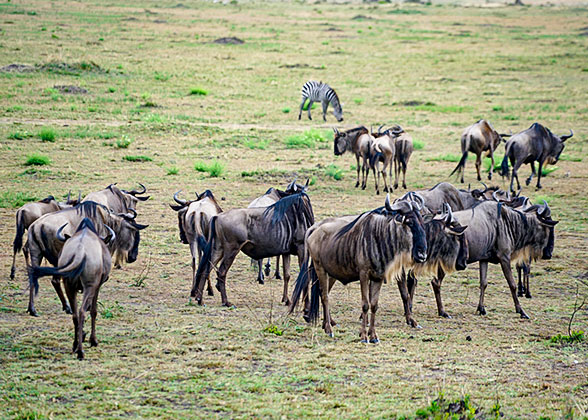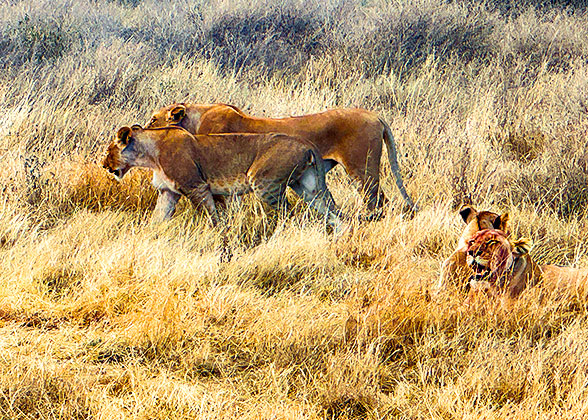Day 1: Arrival in Nairobi, Airport Pick-up
Welcome to Nairobi, the capital of Kenya! Upon landing at the airport, our local professional safari representative will pick you up and transfer you to the hotel. The rest of the day remains free for you. You can rest in the hotel or stroll around freely on your own.
For Your Information:
1. Health Tip: If you depart from countries that have a risk of Yellow Fever transmission or plan to visit countries such as Tanzania, South Africa, and China after leaving Kenya, please remember to get vaccinated and obtain a certification in case of being asked to present it when entering. In addition, we recommend that you take some antimalarial medication to prevent infections.
2. Plastic Bag Ban: Disposable plastic bags are not allowed in Kenya, so we suggest you pack your luggage with paper bags or cloth bags. Plastic suitcases and ziplock bags are ok for use.
3. Keep Your Valuables Safe: It is advised not to hang out carrying a lot of cash and not leave the valuables in the hotel. If you want to play on your cell phone in the taxi, make sure the window is closed, as there may be motor robbers on the street.
For a Safari – Why You Should Go to Kenya?
Because Kenya is one of the best places to admire animals thanks to its reasonable prices and the high density of wildlife. In Kenya, you can drive off-road and watch animals in an extremely short distance, which can provide you with chances to take clear pictures of wildlife and even hear the purr of them. But in other African countries, cars are only allowed to drive along the road, which means you can only watch animals from afar most of the time. Besides, the Mara River in Kenya is the only place to witness the world-famous Mara River crossing of millions of wildebeests!
Accommodation: Four Points by Sheraton Nairobi Hurlingham (4 stars) or similar
|
Day 2: Nairobi: Visit Nairobi National Park, Elephant Orphanage and Giraffe Center
Safari in Kenya In the morning, our guide will pick you up at the appointed time and then drive for 15 minutes to Kenya’s oldest wildlife park, Nairobi National Park, which covers an area of 117 square kilometers (45 square miles). Located on the edge of Nairobi, the southern part of the park is an open border, while to the north of it, buildings of Nairobi form its background, where you can capture the interesting picture of giraffes as tall as skyscrapers in the distance. It's home to more than 100 mammals and 400 birds. When driving in the park, gazelles will stare at the car curiously. You will also encounter lions napping under the tree, cheetahs lurking behind the bushes, and the endangered rhinos grazing on the vast grassland. ► Note: Due to the large number of wild animals in Nairobi National Park, visitors are not allowed to get off the car except at designated places, such as the picnic spots. After that, we will visit the David Sheldrick Elephant Orphanage (SWT Nairobi Nursery), where you can get close to the baby elephants and listen to their stories. You may see a group of young elephants galloping with their ears fluttering toward the nurses to drink milk. After eating, they will play outdoors for a while: some roll in the dust, some play with football, and some fight each other. Our guide will accompany you to arrive ahead of time and occupy a good position so that you can interact with these cute and enthusiastic babies. While viewing, our guide will also tell you each elephant's name and legendary stories. ★ Giraffe Center: Kiss the Tallest Gentleman of SavannaWant to have an intimate date with Mr. Giraffe? Giraffe Center can make it! It mainly breeds the endangered Rothschild's giraffes. Unlike the Masai species, they have light-colored patches with no marks on their legs, which makes them look like wearing white socks. When roaming the wooden paths, these gentlemen will come to you and bend down for food if you feed them. When they eat from your hands, you can feel their soft lips. If daring, you can attempt to feed them from your mouth. As they lick the food from you, you will get a ‘kiss’ from them. ► Tips: 1. Only the food provided by the Giraffe Center can be fed. 2. Although giraffes are docile animals, it is better not to hail loudly while visiting, or they may be startled. Food Safety:We recommend you eat at high-class restaurants in the downtown area of Nairobi, such as CJ’s and INTI, which have a good dining environment and ensure food safety. It is better not to try local snacks sold on the streets, as they may not be clean. While visiting national parks and reserves, we will provide three meals per day, so you don’t have to worry about that. Meal: Breakfast Accommodation: Four Points by Sheraton Nairobi Hurlingham (4 stars) or similar
|
Day 3: Nairobi - Thompson Falls - Lake Nakuru (Admire Flamingos)
After breakfast today, we will first drive for about 3 hours to Nyahururu, where you will enjoy a stunning view of Thompson Falls, the world's most famous equatorial waterfall. The water pouring down from a height of 74 meters (243 ft.) roars in the ever-green valley. You can see the beautiful scenery at the foot of the waterfall when the sun shines through the mist. Following the stone staircases, you can reach its top to enjoy a panoramic view of the surroundings. In addition, you can feel the fun of stepping on the northern and southern hemispheres simultaneously. ► Tip: As the mist may be thick around the waterfall, be careful when climbing the staircases to avoid slipping. We also recommend you wear hiking shoes and waterproof clothes, as you may get wet if you get too close to the fall. After finishing the visit, we will continue to drive for around 1.5 hours to Lake Nakuru National Park in the volcanic zone, which was known as the "paradise of flamingos." There once hosted more than 2 million flamingos, accounting for one-third of the total number of the world, attracting many visitors. However, due to the deterioration of the environment, most of them migrate to Lake Elementaita and Lake Bogoria. This means you have fewer chances to witness millions of these pink birds flying over Lake Nakuru. But the white, lesser flamingos are still common. In addition, more than 400 species of birds inhabit here, such as sooty falcons, shining sunbirds, and red-capped larks. Besides various birds, you could also see around 56 mammals like lions, leopards, antelopes, Rothschild giraffes, rhinos, and other wild animals inside the park. Notes:1. If you are a frenetic fan of flamingos, Lake Bogoria is a better choice. Please get in touch with us ahead of time if you want to rearrange your itinerary. 2. If you visit Lake Nakuru during the rainy season (Mar.-May & Oct.-Nov.), it may be difficult to see birds and animals as the grassland will be divided into small patches by rampant water.
Meals: Breakfast, Lunch, Dinner
Accommodation: Lake Nakuru Lodge - one of the best lodges in Lake Nakuru
|
Day 4: Continue to Drive to Masai Mara National Reserve
The Migration in the Masai Mara Reserve After breakfast this morning, we will drive for around 4 hours to Masai Mara National Reserve, which is the largest game reserve in Africa. Upon arrival, you will first check into the camp to enjoy lunch and rest for a while. After the hot noon, we will start to explore Masai Mara. The sunset on the grassland is beautiful, which will be an unforgettable experience. ★ Experience the Great Migration: Witness the Battle of Wildebeests in Mara RiverThe Great Migration is one of the “50 wonders of the world that cannot be missed”. If you visit Masai Mara from July to September, you will have a chance to see an army of animals more than 10 kilometers (6.2 miles) long, including wildebeest, antelope, and zebra, migrate from Tanzania to Masai Mara to find new grassland. The migration reaches a climax when wildebeests cross the river. Gathering by one side of the river, these warriors will follow the leader's step into Mara River and dash to the opposite bank. Some may be trapped in the mud, and some may be killed by crocodiles lurking in the water. ► Notes: 1. Not all travelers can see the Great Migration and wildebeests crossing the Mara River, as it depends a lot on the route, time, and pace of the migration. But don’t worry! Guides of Masai Mara will share information on wildebeests crossing the river with each other. Our guide will try his best to drive you to the spot and occupy the best position immediately so you will have more chances to see the thrilling scenes. 2. It is advised to keep calm when admiring wildebeests crossing the river to avoid them being startled. ★ Our Strengths on Masai Mara Safari:1. 4x4 pop-up roof land cruiser: Our vehicle can offer you a sheltered safari experience with its enclosed body that can protect you from dust, sunshine, and rainfall. Compared to the minivan provided by other operators, our land cruiser has more comfortable and spacious seats, and can offer you an elevated view while game driving. In addition, it can drive you to anywhere on the savanna regardless of the tough road conditions. 2. Many tours provided by other operators only arrange two days in Masai Mara, while we schedule three days, which will increase your chances of witnessing the Great Migration. 3. The camp we booked for you is near Mara River, and it is convenient to reach the animal area. Sometimes, you will encounter antelopes grazing near the camp, see crocodiles, and hear the roar of hippos in the Mara River. Meals: Breakfast, Lunch, Dinner Accommodation: Ashnil Mara Camp (4 stars)
|
Day 5: Enjoy Full-day Game Drive in Masai Mara
The following two days will be devoted to Masai Mara National Reserve. Our guide will drive you to spot the African Big Five: lions, leopards, rhinoceros, elephants, and Cape buffalo. Trophy hunters gave the title in the late 1800s, as they are considered animals that are the most difficult to prey on. Nowadays, they are regarded as the symbols of Africa. In addition to the Big Five, other rare animals, such as wildebeest, giraffes, and colobus monkeys, are worth viewing. If you are lucky, you will encounter the Incredible Five, a killer group of 5 cheetahs, but only 3 survive now. At noon, you will enjoy a picnic lunch near the Mara River.
► Tips:
1. Please avoid roaming around without the accompaniment of our guide when having the picnic.
2. Remember to take a telephoto lens if you want to capture clear pictures of animals. In addition, please avoid groveling on the top of the car in case of danger, and you may be fined by the park staff.
3. Bring a thick coat as the temperature will decrease at dusk on the savanna.
Meals: Breakfast, Lunch, Dinner
Accommodation: Ashnil Mara Camp (4 stars)
|
Day 6: Another Full-day Exploration in Masai Mara
Today, we will continue to feel the charm of the wild. The vast grassland attracts about 95 kinds of mammals and 450 kinds of birds to inhabit. Our guide will try his best to drive you to witness the wildebeests crossing the river if you failed to see in the past two days. Besides the Great Migration, Masai tribes are also worth visiting. Masai people have lived in harmony with animals for hundreds of years, and Masai Mara is named after them. If time permits, you could be escorted to visit their settlements. Getting out of the car, you could see huts built with cow dung and mud surrounded by fences used to protect their livestock. Roaming around, you will be warmly greeted by locals in vibrant clothes, usually red. ► Watch Out: Local Masai Mara people may ask visitors to donate or buy their overpriced jewelry. Be aware of that and reject them if you don’t feel comfortable.
After the morning game drive, we will return to the camp for lunch and take a break. When animals wake up from their naps in the afternoon, we will go on our game-viewing drive until sunset. Get your camera ready! It’s the best time to capture the silhouettes of animals and acacia at sunset. Meals: Breakfast, Lunch, Dinner Accommodation: Ashnil Mara Camp (4 stars) Spot the Hippos The Masai Mara Tribe
|
Day 7: Drive Back to Nairobi, Airport See-off
Today will be the last day of your Kenya safaris from Nairobi. After breakfast at the camp, we will drive for about 5 hours to Nairobi International Airport for your return flight. As the security check is slow at the airport, we recommend you book the flight that will take off in the afternoon or evening in case you miss it.
Regret not seeing the Great Migration? Then, continue to visit Serengeti National Park in Tanzania, which has vaster grassland and more animals. Please feel free to contact our travel consultant if you are interested. It will be our honor to continue to serve you!
Meal: Breakfast
|



